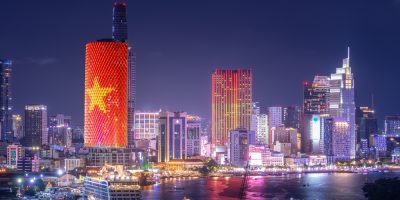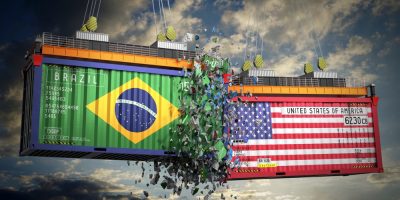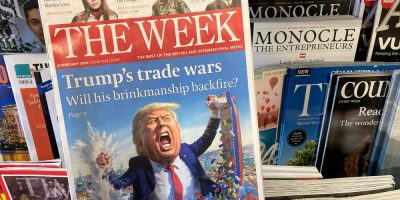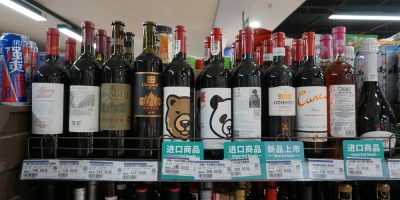-
ÉTATS-UNIS
-
Vietnam
Assessing the US-Vietnam Framework Agreement on Trade
13 juillet 2025
- Distribution
- Impôts
The recent announcement of a landmark trade agreement framework, following just three months negotiations since President Trump’s tariffs announcement on 2 April 2025, signals a pivotal shift, not merely in bilateral relations, but in the broader architecture of global supply chains.
As a commercial lawyer with exposure to Vietnam since 2007, I have observed the evolving dynamics between the United States and Vietnam through the years, talking to students, entrepreneurs, veterans, diplomats, humans from all walks all life, from both nations and beyond.
You may recall that Vietnam, with the notable exclusion of China, was to be the nation that would encounter the most stringent tariffs imposed by the Trump administration, reaching an astonishing 46%.
The newly forged framework outlines significant reciprocal concessions designed to foster greater trade and investment flows. Granted, pre-April 2 tariffs applied by the USA on Vietnamese goods were lower than what emerges from the framework agreement, but still, it is better than 46%),
The United States has committed to imposing a 20% tariff on most Vietnamese imports, a notable reduction from the previously mooted 46%. However, a substantial 40% tariff will apply to goods re-exported from third countries, with a particular focus on those originating from China.
Vietnam has pledged to open its market to a wide array of US products. Crucially, it has also committed to implementing stringent measures aimed at restricting the transshipment of Chinese goods through its territory, a long-standing concern for Washington.
In a significant win for American exporters, US goods will now enjoy duty-free access to the Vietnamese market, effectively granting “total access”, particularly for large-engine vehicles such as SUVs, as emphatically stated by President Trump (how SUVs are going to circulate in the narrow alleys of Hanoi and Ho Chi Minh City, infested by swarms of mopeds, is a different story).
This agreement is expected to catalyse growth in several key sectors. Electronics, textiles, furniture, energy (especially Liquefied Natural Gas), and agriculture are poised for expansion. US firms specialising in manufacturing technology, energy solutions, and agricultural products are anticipated to be the primary beneficiaries. Furthermore, beyond immediate trade benefits, the agreement is set to reshape investment strategies, encouraging a greater localisation of supply chains within Vietnam. This strategic realignment is also expected to further solidify the already robust US-Vietnam Comprehensive Strategic Partnership.
While the potential upsides are considerable, it is imperative for businesses and investors to approach this new landscape with a clear understanding of the accompanying risks. From my vantage point, I identify several significant execution challenges and structural impediments that require close monitoring.
Enforcement of Transshipment Controls
The most immediate and perhaps formidable risk lies in the effective enforcement of transshipment controls. Vietnam has historically served as a significant assembly point for Chinese-manufactured components. Ensuring that goods originating from China are not merely re-routed through Vietnam to circumvent US tariffs will require exceptionally close monitoring and robust verification mechanisms. The legal and practical complexities of definitively determining the true country of origin for all goods will undoubtedly pose a persistent challenge. As a European citizen, witnessing how the EU-Vietnam Free Trade Agreement (“EVFTA”), which poses an important stress on certificates of origin, I am particularly aware of this matter.
While Vietnam has made remarkable strides in its economic development, certain structural issues could hinder its capacity to scale up high-value manufacturing in the short to medium term. These include:
Legal framework nuances
Vietnam’s legal framework for foreign investment has seen continuous improvements, but legal and cultural complexities and inconsistencies can and do still arise. Navigating the regulatory landscape, particularly with new rules stemming from this agreement and at a time of deep administrative, governmental, digital and legal reforms in Vietnam, will demand expert legal guidance to ensure compliance and mitigate potential fines and disputes. Issues surrounding so-called sublicences for businesses, intellectual property rights enforcement and contract enforceability, whilst improving, still require careful consideration;
Education
The ambition to transform Vietnam into a high-value manufacturing hub necessitates a workforce equipped with advanced skills. While the Vietnamese government prioritises education and workforce development, a significant portion of the current labour force lacks formal training and specialised certifications, let alone a good command of the English language. Bridging this skills gap, particularly in areas like advanced manufacturing, engineering, and digital technologies is a necessity and not just in light of this framework agreement. Companies may need to factor in substantial investment in training and upskilling programmes for their Vietnamese employees.
Infrastructures
Despite considerable investment, Vietnam’s infrastructure, particularly in logistics, energy, and transportation, continues to face bottlenecks. And China – the apparent target of Trump’s tariffs – is stepping in with high-speed trains connecting it to the northern Provinces of Vietnam. An increased volume of high-value manufacturing and trade will place further strain on existing infrastructure. Inadequate port capacity, congested roads, and a reliable energy supply (including for EV charging) are critical concerns that could impact efficiency and increase operational costs for businesses.
Policy divergence
This framework agreement deepens US-Vietnam trade ties and seems to be paving the way for more US investments in Vietnam, but this second aspect seems to run counter to parallel US policy objectives aimed at reshoring manufacturing back to the United States. This potential divergence in strategic priorities could introduce yet another element of unpredictability in the long term, necessitating a flexible and adaptable investment approach. Future shifts in US policy could impact the durability and full extent of the benefits derived from this agreement.
This trade agreement, if finalised and implemented, undoubtedly represents a structural shift in global trade dynamics. It strategically positions Vietnam as an increasingly important high-value manufacturing hub and significantly deepens US engagement in Southeast Asia. We will need time, however, to assess the practical impact of the agreement, observing the efficacy of its implementation, and understanding how Vietnam’s inherent strengths and challenges will ultimately shape its role in the reconfigured global supply chain.
We will also need to see what China, if anything, will do as a countermeasure. In fact, any assessment of Vietnam’s evolving trade landscape would be incomplete without a thorough consideration of China’s influence and strategic posture. President Xi Jinping has consistently championed a vision of a “community of shared future for mankind,” a concept that, while outwardly promoting global cooperation, also subtly underscores a demand for international alignment with Beijing’s interests. In the context of escalating trade tensions, Xi has repeatedly warned that “trade wars have no winners,” advocating for unity against protectionist measures, yet simultaneously implying that nations must ultimately choose sides, either with or against China’s economic and political orbit. Vietnam, despite its historical complexities and occasional maritime disputes with Beijing in the South China Sea (or East Sea, as it is officially called by Hanoi), remains deeply interwoven with China’s economy. China has been Vietnam’s largest trading partner for many years, with significant inflows of Chinese FDI, loans, and project contractors. This economic dependency is particularly evident in various sectors, where Chinese components and materials form a substantial part of Vietnamese manufacturing supply chains. While Vietnam has actively sought to diversify its trade partners and reduce its reliance on China, the sheer scale of the bilateral economic relationship means that disentanglement is a long-term, complex endeavour. Furthermore, China’s influence extends beyond direct trade into crucial regional resources. The Mekong River, a lifeline for millions in Southeast Asia, originates in China, which has constructed numerous upstream dams.
As Vietnam navigates its enhanced trade relationship with the United States, it must simultaneously contend with the enduring economic gravity and strategic ambitions of its northern giant neighbour. Any perceived move by Vietnam to significantly shift away from China could invite retaliatory measures or heightened pressure from Beijing. Businesses investing in Vietnam must not only grasp the intricacies of the US-Vietnam agreement but also meticulously analyse how these developments will intersect with, and potentially be impacted by, the intricate, often delicate, and sometimes fraught relationship between Hanoi and Beijing. Understanding this geopolitical tightrope will be essential for sustainable success in the Vietnamese market. Prudence, informed legal counsel, and a keen eye on evolving geopolitical and economic realities will be paramount for those seeking to capitalise on this transformative new chapter.
Takeaways
- Tariffs:The US-Vietnam framework agreement marks a significant departure from previous trade dynamics, reducing US tariffs on most Vietnamese imports to 20% (from a mooted 46%) while imposing a 40% tariff on transshipped goods, especially from China.
- Vietnam’s market opening:Vietnam has committed to duty-free access for a broad range of US products and stricter controls on Chinese goods transiting its territory.
- Growth / manufacturing shift potential:The agreement is expected to fuel expansion in Vietnamese electronics, textiles, furniture, energy (LNG), and agriculture. It also encourages supply chain localisation within Vietnam (normally more of an assembly point for Chinese products).
- Execution challenges: Effectively preventing the re-routing of Chinese goods through Vietnam to avoid tariffs will be a complex and demanding task; Despite economic progress, Vietnam faces hurdles in scaling high-value manufacturing due to legal framework nuances (e.g., sublicences, IP enforcement), a skills gap in its workforce (lack of formal training, English proficiency) and infrastructure bottlenecks (logistics, energy, transportation).
- US policy divergence:The agreement’s encouragement of US investment in Vietnam appears to contradict the broader US policy objective of reshoring manufacturing.
- China:Businesses must consider China’s significant economic sway over Vietnam, including its position as Vietnam’s largest trading partner, its FDI, and its control over shared resources like the Mekong River. Any major shift by Vietnam away from China could lead to retaliatory measures from Beijing.
- Uncertainty:This is not a final agreement, so the situation might change. Prudence and informed legal counsel are crucial for businesses navigating this evolving landscape.






















